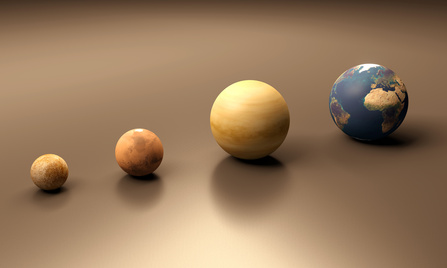The inner planets Venus, Earth and Mars are excellent examples of why some planets become habitable while other do not. Venus had a similar origin to the planet earth but it lies on the inner border of the ecosphere. It probably had oceans when the sun was less luminous before entering the main sequence. The temperature rose to six thousand degrees kelvin. Volcanism in the planet`s past pumped much carbon dioxide into the atmosphere. Since the planets’ oceans had boiled off there was no water to transform the carbon dioxide back into rock causing a runaway greenhouse effect to occur.
Mars probably had oceans in it’s early days when it had a thicker atmosphere of carbon dioxide due to greater geological activity. Low gravity caused the carbon dioxide gas to escape and the greenhouse effect weakened. The oceans evaporated and the planet was left cold and dry (Gore,R p 24 National Geographic January 1985). Conversely, Earth, by being far enough away from the sun was able to retain it’s oceans and therefore support life.
Some of the latest discoveries were made by Nasa’s Kepler telescope in 2011 was Kepler-22b which is 600 light years away and 2.4 times the radius of earth. This was the first earthlike planet to be observed within the habitable zone of a G type star. Its mass it unknown but it is believed to have an ocean surface from which life could be present. Also in 2011 Gliese 66Cc was discovered radial velocity method. (Doppler shifts in the planet’s class M star due to the planets gravitational orbit) It is a super earth that is about 3.8 to 4.5 times the mass of earth and is 0.125 AU from it’s star which is a red dwarf. Because of this fact it is probably tidal locked. One side only faces it’s sun. However the terminator zone which lies in on the edge of facing on and facing away could be habitable. If the planet has a dense atmosphere then the heat from the M star striking the terminator zone could heat up the dark side of the planet to habitability.
The Kepler telescope has also discovered Kepler-186f in 2014. This planet is similar to earth’s mass and radius 1.44 times and 1.17 times respectively. It orbit is 0.43 AU from the parent star a red dwarf. It might not be habitable even though it is in the habitable zone because it might not have an atmosphere. The atmospheric status is unknown because of its great distance from earth being 580 light years. The Kepler telescope and even the James Web telescope (launched December 25 2021) are not advanced enough to determine this. In 2016 the radial velocity method discovered another planet that is relatively quite close to earth Proxima b orbiting Proxima Centauri.(part of the triple Alpha Centauri star system) only 4.25 light years away. It’s mass and radius are 1.3 and 1.17 times the earth respectively. Although Proxima Centauri b is in the habitable zone( 0.05 AU), it is not known if it has an atmosphere and maybe not due to Proxima Centauri being a red dwarf flare star. The increased solar wind and energy may have striped the exoplanet of it’s atmosphere.
The Kepler telescope also discovered K2-18b in 2015 using the period diming method.(star dims every time the planet eclipse it.) It is about 120 light years from earth and orbits a red dwarf star in the habitable zone. It is about 8 times the mass of earth. In 2023 the James Web telescope discovered evidence of methane and carbon around the planet. The scientists think it may be a Hycean planet, a planet with a hydrogen atmosphere and a surface of water. On the planet earth phytoplankton mostly creates the chemical dimethyl sulfide. This chemical has been detected on the planet K2-18b, indicating that at least privative life is probable on the planet.
In September of 2023 Kindai University in Japan and the National Astronomical Observatory of Japan have done computer simulations of planetary actions and abnormalities within our solar system and this suggests that in the Kuiper Belt there could be a planet that is one and a half to three times the mass of earth and about 250 to 500 AU to the sun (AU =earth-sun distance). and a thirty degree orbit compared to plane of the rest of the planets. Expect Pluto which was demoted as a non planet in 2006 which has an orbital plane of about 17 degrees to the plane of the rest of the solar systems planets. I know this might be a stretch to think that this is an earth like planet being not in the habitable zone of our sun but it might have an internal energy source and a rocky surface plus/or a frozen ice surface with liquid water beneath. This is like Jupiter’s moon Europa. The internal energy source would most likely be undersea volcanic. (Unlike Europa which probably has an external energy source of a tidal nature caused by Jupiter’s gravity.) Thus making the planet habitable for marine life.
